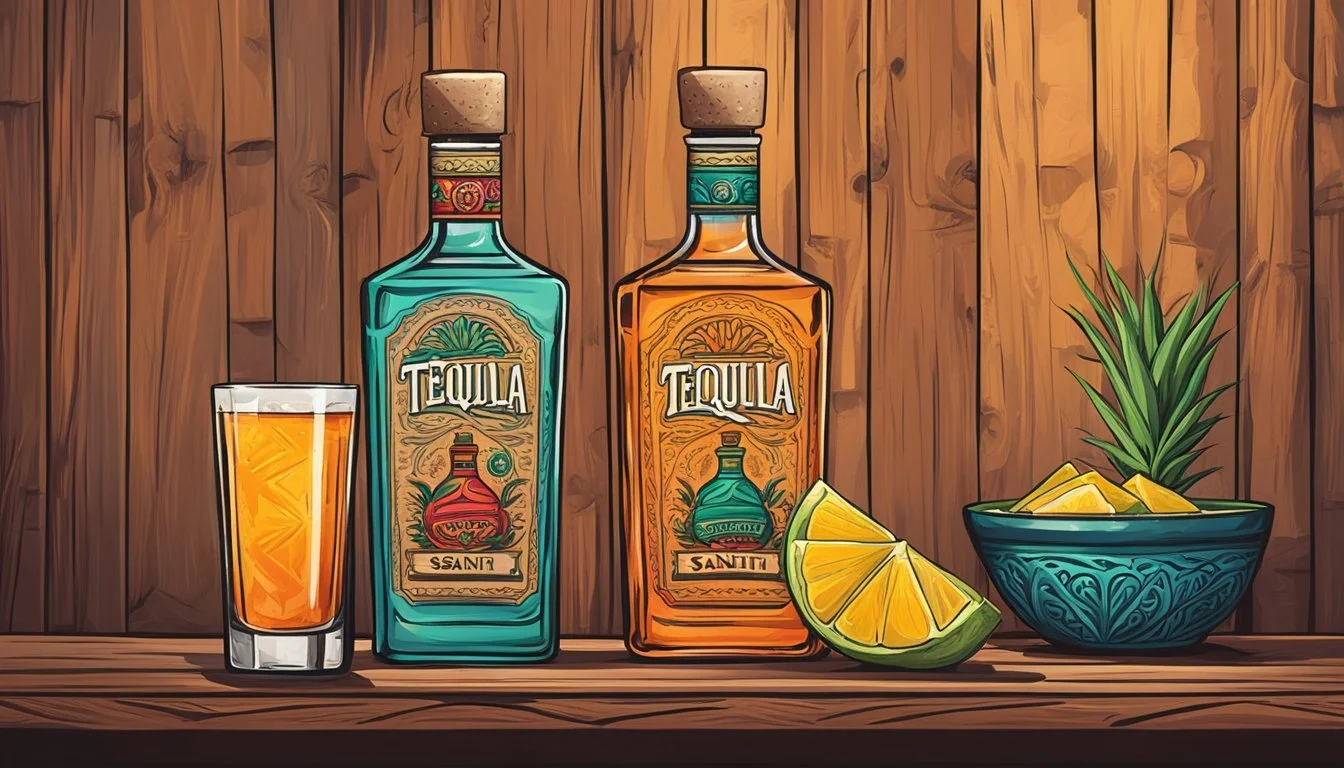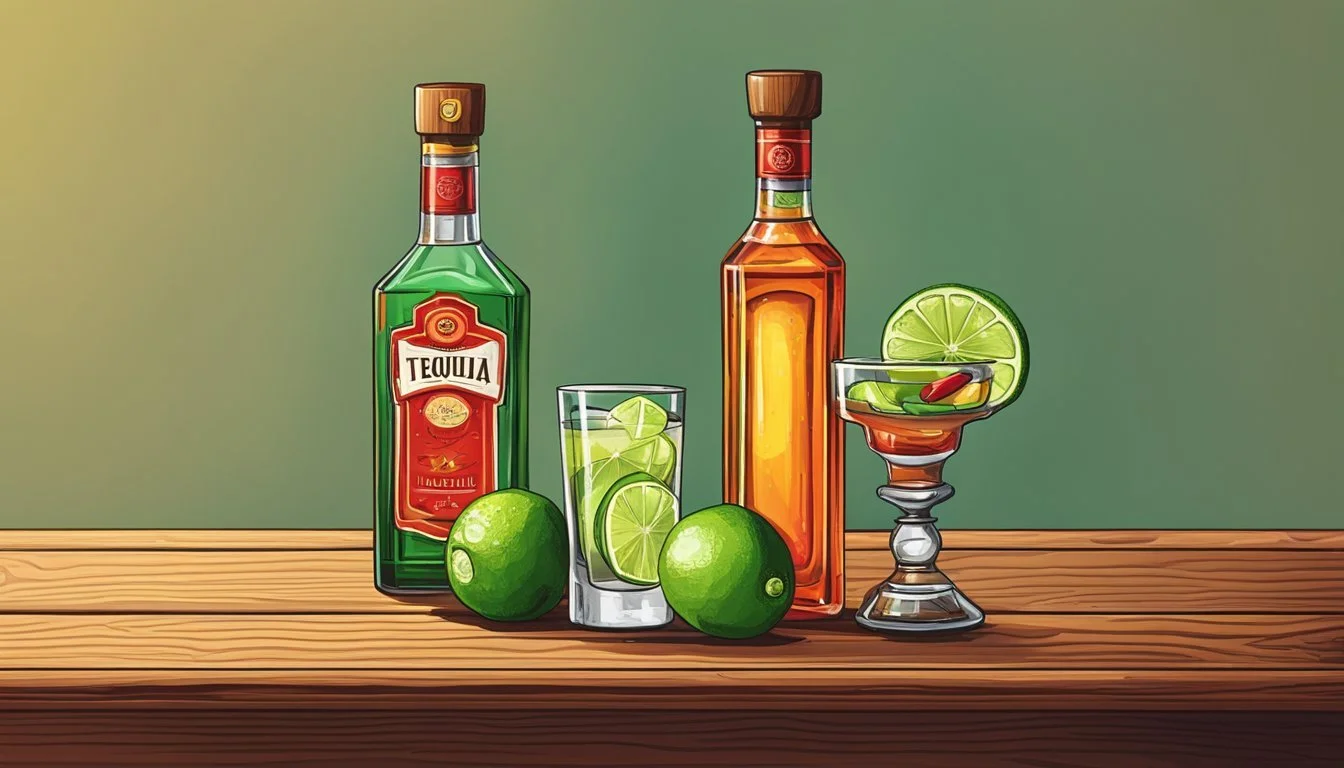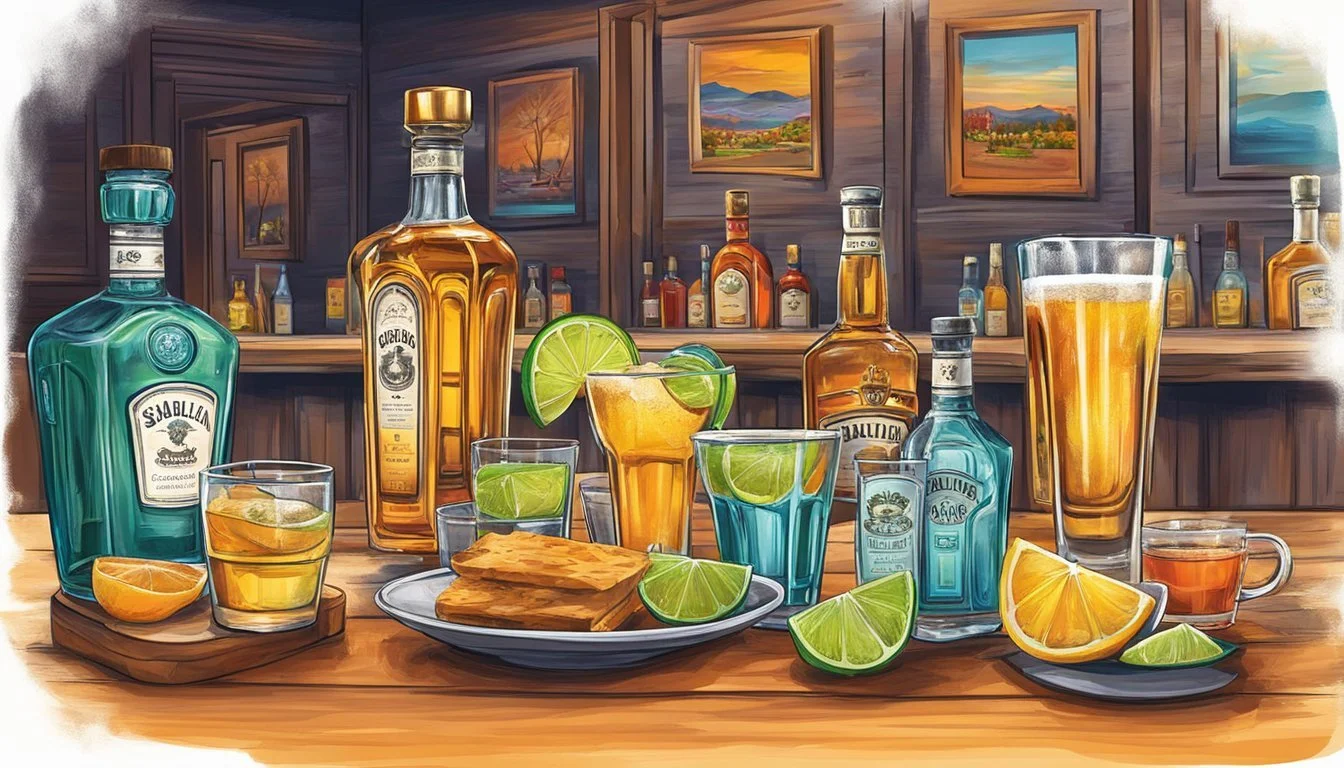Tequila and Sangrita
Embracing Tradition with Texas' Favorite Mexican Duo
In the vibrant culinary landscape of Texas, the rich traditions of Mexican culture infuse the local gastronomy, often leading to a celebration of flavors that are both authentic and innovative. One such tradition is the pairing of tequila with sangrita, a customary Mexican drink that marries the spirit's robust character with a tangy, spicy chaser. This duo extends beyond the borders of Mexico and has found a harmonious place in the Texan dining scene, where the appreciation for tequila's complexities is on the rise.
Tequila, Mexico's storied spirit, distilled from the blue agave plant, is often enjoyed neat in its homeland. In the heart of Texas, these spirits are sipped with equal reverence, with aficionados seeking the earthy nuances of high-quality blanco or the aged depth of reposado and añejo varieties. Sangrita, with its literal translation to 'little blood', is the vivid companion to tequila, known for its bright red hue and piquant flavor profile derived from a mixture of citrus juices, spices, and sometimes tomato.
While Texans embrace the barbecue and Tex-Mex fare that their state is famous for, many also turn to traditional Mexican pairings to enhance their culinary experience. Sangrita, served alongside tequila, is sipped in a ritual sequence that enhances the flavors of both components, creating a balance of the spirit's potency with the chaser's acidity and sweetness. This pairing is a testament to the enduring bond between Texas and its southern neighbor's rich cultural heritage.
The History and Cultural Significance
The pairing of tequila and sangrita carries a profound cultural heritage reflective of Mexico's spirit and tradition, integral to the nation's identity.
Origins of Tequila
Tequila's history is deeply rooted in the region of Jalisco, Mexico, where the blue agave plant—agave tequila Weber—flourishes in the volcanic soil. The distillation of agave to produce spirits dates back to the 16th century. It was officially recognized as "tequila" by the 20th century, signifying its specific geographic origin, much like Champagne in France. Today, tequila is inextricably connected to Mexican culture, symbolizing both national pride and artisanal craftsmanship.
Key Components of Tequila:
Primary Ingredient: Blue agave nectar
Location of Origin: Jalisco, Mexico
Significance: Represents Mexican heritage and pride
Sangrita: The Classic Companion
Sangrita, which translates to "little blood," is a customary accompaniment to tequila that originated in Jalisco, Mexico, possibly since the 1920s. Unlike its alcoholic counterpart, sangrita is a non-alcoholic chaser that enhances the rich earthy nuances of tequila. Traditional recipes often combine orange juice, lime, and a spice mixture that could include hot sauce or chili powder, with the potential addition of tomato juice to create a balance of sweet, sour, and spicy flavors.
Typical Ingredients in Sangrita:
Citrus: Orange juice and lime
Spice: Hot sauce or chili powder
Additional: Tomato juice, salt
Function: Serves as a palate cleanser and flavor enhancer for tequila
Understanding Tequila
In exploring the traditional Mexican beverage Tequila, it's essential to understand its varieties, production process, and distinct tasting notes which set it apart from other agave spirits such as Mezcal.
Types of Tequila
Tequila is divided into several categories based on aging time:
Blanco (or Silver) Tequila: Unaged, bottled immediately after distillation, showcasing the purest flavor of the agave nectar.
Reposado Tequila: Aged between 2 months to 1 year in oak barrels, which imparts a golden hue and a balanced palate.
Añejo Tequila: Aged from 1 to 3 years, often in small oak barrels, offering a smoother, richer, and more complex flavor profile.
Production Process
The process to produce quality tequila begins with the blue agave plant, primarily found in Jalisco, Mexico:
Harvesting: Mature agave plants are harvested for their hearts, known as "piñas".
Cooking: The piñas are then cooked to convert starches into sugars.
Fermentation: Cooked agave is mashed and fermented, converting the sugars into alcohol.
Distillation: The liquid is distilled to increase its purity and alcohol content.
Aging (optional): The distilled product may be aged in barrels to create reposado or añejo varieties.
Tequila Tasting Notes
When tasting tequila, consider the following notes that characterize its quality:
Blanco Tequila: A crisp and robust flavor profile marked by a strong presence of agave, citrus, and peppery notes.
Reposado Tequila: An enhanced balance between the wood's influence and the agave's essence, often adding hints of vanilla or caramel.
Añejo Tequila: A complex interplay of flavors such as oak, smoke, and sweet agave nectar, creating a smooth and luxurious finish on the palate.
Understanding these fundamental aspects of tequila ensures that you can better appreciate this traditional Mexican spirit.
Exploring Sangrita
Sangrita, a traditional Mexican chaser, complements the flavors of tequila with its tangy and spicy profile. Traditional recipes often feature a balance of tart and sweet flavors, achieved by combining citrus juices with tomato and a touch of heat from spices.
Classic Sangrita Recipe
A classic Sangrita recipe typically involves the following ingredients:
Tomato juice: The base of Sangrita, providing a savory depth.
Orange juice: For a sweet balance to the tomato's savoriness.
Lime juice: Adds a necessary citrus tang to the mix.
Pomegranate juice: Often used to introduce a fruity sweetness that pairs well with the acidity.
Salt: Enhances the overall flavor profile.
Chili powder or hot sauce: Introduces that characteristic spice.
To prepare a traditional Sangrita, one could follow these steps:
In a pitcher, combine 1 cup of tomato juice with 1/2 cup of orange juice and 1/4 cup of lime juice.
Add 1/4 cup of pomegranate juice for sweetness and color.
Season with salt to taste, often about 1/2 teaspoon.
Introduce heat with a pinch of chili powder or a few dashes of hot sauce, adjusting to one's preference.
Stir well and let the mixture chill in the refrigerator to allow the flavors to meld.
Serve cold alongside a shot of tequila, sipping alternately.
Regional Variations
Across different regions, Sangrita recipes vary to reflect local tastes and ingredients. While the classic Sangrita recipe remains a staple, regional variations might include:
Additional fruits: Some regions may add or substitute fruit ingredients, such as pomegranate or tangerine juice, for differing sweetness and acidity profiles.
Variety of spices: Apart from chili powder, choices of spice could include ground peppers of various heats and flavors.
In some parts of Mexico, the beverage may steer away from tomato juice altogether, favoring a mixture focused on citrus and spice. On the other hand, some Texas interpretations might incorporate local hot sauce varieties or even a splash of tequila into the Sangrita itself for an extra kick. One commonality across all variations remains the aim to balance the savory, sweet, and spicy to complement the bold flavors of tequila.
The Art of Pairing Tequila with Sangrita
In the vibrant traditions of Mexico, now embraced in Texas, tequila and sangrita stand together as a classic duo, each enhancing the other's flavors to create a balanced tasting experience.
Perfect Pairing Principles
One's palate should be the guide when pairing tequila with sangrita. The intensity of tequila, categorized in types such as blanco or reposado, should be matched with a sangrita recipe that complements its flavor profile without overpowering it. A blanco, with its crisp and fiery nature, pairs beautifully with a sangrita that has a refreshing citrus tang. In contrast, a smoother reposado might harmonize better with a subtly sweet sangrita that can soothe its oak-aged softness.
Tequila Blanco: Look for a sangrita with higher acidity to balance the raw, peppery notes.
Tequila Reposado: A sangrita with sweeter notes will counterbalance the tequila's mild oak tones.
The key is balance — a sangrita should counterbalance the tequila's robust flavors, invigorate the palate, and prepare it for the next sip, creating an alternating savoring rhythm.
Recipes and Recommendations
A traditional sangrita recipe might include:
Ingredient Quantity
Tomato Juice 1 part
Orange Juice 1 part
Lime Juice 1/2 part
Hot Sauce To taste
Salt and Pepper To taste
For an inventive take incorporating Texas flavors, one might use:
2 kale leaves
1 tbsp 100% Blue Agave Syrup
0.25 tsp vanilla extract
In a pitcher, combine the juices of tomato, orange, and lime. Season with salt, pepper, and hot sauce as desired. For a twist, blend kale leaves into the mixture, adding a touch of agave syrup and vanilla extract for sweetness. Keep the sangrita chilled.
When choosing tequila, opt for high-quality blanco or reposado that offers a pure expression of the agave plant. The sangrita recipe should precisely counterpoint the selected tequila's individuality, whether it favors the earthy undertones of an aged tequila or the zesty bite of a younger one. Tequila and sangrita isn't just a drink pairing; it's a cultural symphony of flavors appreciated by connoisseurs and casual drinkers alike.
Tequila and Sangrita in Social Settings
Tequila, when sipped alongside sangrita, forms a revered Mexican pairing that has found its way into social gatherings throughout Texas, further enriching its vibrant cultural tapestry.
Traditional Occasions
Texans with Mexican heritage often maintain deep-rooted traditions that center around food and drink, especially during family gatherings and regional festivities. Tequila holds a place of honor in these celebrations, frequently accompanied by sangrita, a spicy and tangy Mexican drink. It is common to see this duo served in a ceremonial fashion, with a pitcher of sangrita next to a collection of shot glasses filled with premium tequila. Such occasions may include savory dishes like tacos and guacamole, emphasizing the communal and festive spirit of the gathering.
Tequila: Reserved for toasts and slow appreciation.
Sangrita: Served chilled, enhancing the flavor of the accompanying tequila.
Glassware: Often, clay cups or small glasses for an authentic experience.
Modern Celebrations
In more contemporary Texan social scenes, tequila and sangrita have transcended traditional boundaries and become a sophisticated option for diverse audiences. Many upscale bars and gatherings offer this combination as a cocktail experience, presenting a twist on a classic that respects the original flavors while introducing novel presentations. The inclusion of tequila and sangrita can transform a typical gathering into a cultural homage, pairing them with modern takes on traditional foods like upscale versions of tacos infused with global flavors or artisanal guacamole.
Innovative Pairing: Bartenders may infuse sangrita with ingredients like pomegranate or cucumber for a fresh take.
Presentation: A modern twist might include serving the duo on a curated platter, each shot nestled beside a miniature lime wedge and dusting of gourmet salt.
Health and Nutritional Aspects
When enjoying Tequila and Sangrita, it's important to consider the nutritional content and potential health benefits, as well as moderate consumption due to the alcoholic content in tequila and sugar levels in sangrita.
Caloric and Nutritional Content
Tequila typically contains about 64 calories per 1-oz serving, with 0 grams of carbohydrates, fat, and protein. It's important to note that these calories come purely from the alcohol content. In contrast, a typical serving of Sangrita can vary widely in caloric and nutritional content based on ingredients, such as citrus juices and grenadine, which contribute to its carbohydrate and sugar content.
A basic Sangrita recipe per serving may include:
Calories: Approximately 70-100
Carbohydrates: 15-20 grams
Sugars: 10-15 grams
Vitamin C: Contributed by citrus juices
Sodium: Minimal unless salt is added
Benefits and Cautions
Tequila, when consumed in moderation, does not contain carbs, fat, or protein and thus doesn't significantly affect blood sugar levels. However, excessive alcohol intake can have negative health impacts. Sangrita offers nutritional benefits from its citrus components, such as Vitamin C and potassium. Yet, it's advised to be cautious of the high sugar content, as it can contribute to increased caloric intake.
Non-Alcoholic Alternatives
For those seeking a non-alcoholic alternative, a virgin Sangrita can be enjoyed. It retains the flavor profile minus the alcohol content from tequila. Non-alcoholic Sangrita's nutritional content remains similar, emphasizing the importance of being aware of sugar and calorie content. Traditional Sangrita is alcohol-free, making it a suitable chaser for non-alcoholic tequila alternatives.
Conclusion
In Texas, the pairing of tequila with sangrita reflects a cultural appreciation for traditional Mexican spirits. This duo offers a balanced and versatile drinking experience. Tequila, recognized for its earthy and complex flavors, finds an ideal companion in sangrita, a spicy and tangy chaser that complements rather than overpowers.
The preparation of sangrita varies, but the core principles hold steady—a mix of sweet, sour, and spicy that enhances the tequila's profile. Texas' fondness for bold flavors embraces the traditional recipe of sangrita, incorporating local ingredients to add a unique twist while preserving the balance critical to its success.
Texans appreciate the versatility of this pairing, suitable for a range of occasions, from casual gatherings to formal celebrations. With an informed approach to this time-honored tradition, Texas offers a refreshing embrace of these beloved beverages.
Tequila: Enjoyed in moderation, it stands as a testament to Mexico's rich cultural heritage.
Sangrita: It acts not just as a chaser but as a flavor enhancer, encouraging a slower, more savory consumption of tequila.
In summation, the celebration of tequila with sangrita within Texas embodies a confluence of respect for tradition and a penchant for culinary adventure.








